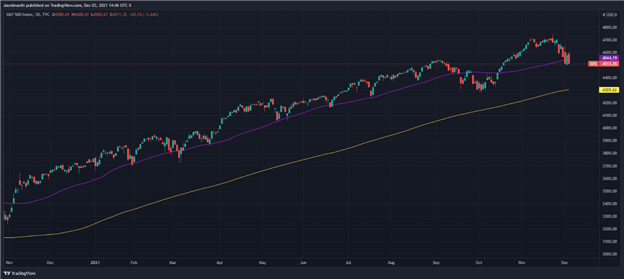S&P WEEKLY OUTLOOK: SLIGHTLY BEARISH
- Volatility has spiked in recent days on growing concerns about the pandemic
- The S&P 500 has trended lower as traders have trimmed their exposure to risk assets
- Though the fundamental backdrop remains supportive for most U.S. stocks on strong corporate earnings and constructive profit outlook, omicron variant uncertainty will drive price action in the near-term
Most read: Metaverse Cryptocurrencies: What Exactly Are You Buying?
Wall Street has been on a roller coaster ride in recent days. Friday after the Thanksgiving Holiday, US stocks tumbled on pandemic fears, but regained some ground on Monday, before falling sharply on Tuesday and Wednesday as the Fed signaled it may accelerate the QE wind-down process and the CDC identified the first cases of the Omicron COVID-19 variant in the country. On Thursday, we saw some relief as dip buyers pounced, but sellers resurfaced just before the weekend to dump stocks following mixed U.S. economic data and coronavirus angst.
For the week ahead, there is not much reason to be optimistic yet. While the start of December is usually a good period for the S&P 500 and other equity indices, the Fed’s recent pivot towards faster tapering and more importantly, uncertainty about the course of the ongoing healthcare crisis are undermining risk appetite. With little information on the omicron strain at this time, the prevailing cautious sentiment among investors will not change overnight and algos will continue to dump shares as headlines of new infections in the U.S. hit the wires.
In the current environment, volatility is likely to stay elevated, with the main averages (S&P 500, Dow, Nasdaq 100, Russell 2000) and particularly the reopening theme (airlines, cruises, restaurants, hotels, etc.) biased to the downside. Despite this outlook, betting on directionality may be a risky proposition until we learn more about omicron, but that doesn’t mean there aren’t opportunities out there. That said, traders can still benefit from the ongoing market dynamics by focusing on strategies that capitalize on high volatility such as straddles on high beta assets, perhaps those that have already moved a lot recently (in case of a reversal).
Focusing on fundamentals, the U.S. economy seems to be stabilizing after the summer’s rough patch. This is good news for fourth quarter earnings and probably beyond. Granted, Friday’s November NFP results disappointed, coming in at 235,000 versus the expected 550,000, but this number could be revised significantly higher next month considering that the Household Survey contradicted the Establishment Report by a wide margin (the Household Survey showed 1.14 million jobs created vs 235,000 in the Establishment Survey).
Elsewhere, the November’s Non-Manufacturing ISM was a blockbuster report.
According to the PMI release, activity in the services sector soared to an all-time high of 69.1, well above consensus estimates of 65. The recent string of solid data suggests that US GDP could grow at an annualized rate of 9.7% in the final three months of the year, following the 2.1% increase in the third quarter. Heading into 2022, a strong recovery is positive for corporate profits, and thus their stock prices, but none of this matters in the short term as traders are more focused on the newly discovered Omicron variant and its implications on the global economy.
Personally, until I know more about this strain, I’d avoid taking large directional positions in risk-assets, including the S&P 500, though I may consider volatility instruments (VIX, for example).
S&P 500 DAILY CHART
S&P 500 (SPX) Chart by TradingView
EDUCATION TOOLS FOR TRADERS
- Are you just getting started? Download the beginners’ guide for FX traders
- Would you like to know more about your trading personality? Take the DailyFX quiz and find out
- IG’s client positioning data provides valuable information on market sentiment. Get your free guide on how to use this powerful trading indicator here.
—Written by Diego Colman, Contributor



Be the first to comment